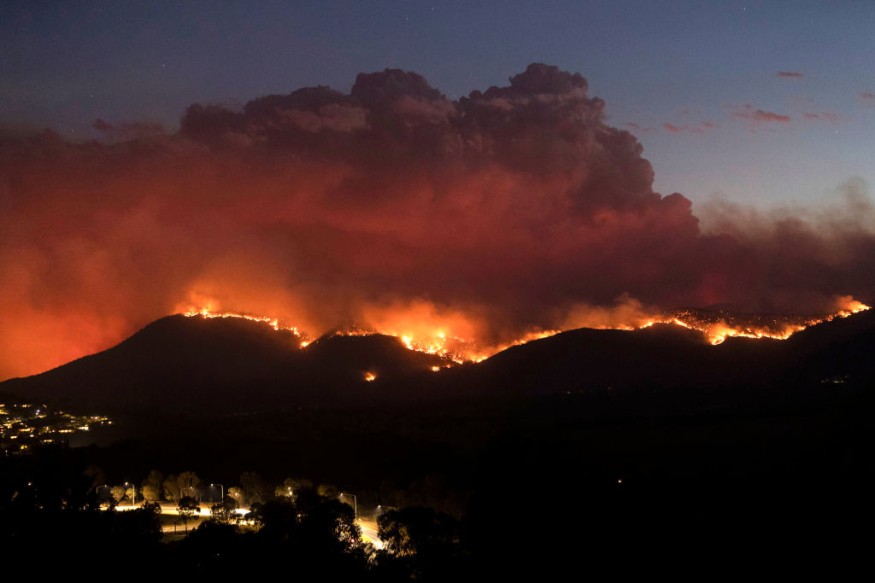When a group of scientists looked at events that affected the world's climate in 2020, they took care to include in the pandemic-related emissions reductions that resulted in cleaner skies over numerous cities.

According to their findings, the disastrous bushfires that swept through Australia from late 2019 to 2020, spewing plumes of smoke that reached the stratosphere and circled most of the southern hemisphere, had a more direct influence on global climate.
"The major climatic forcing of 2020 wasn't COVID-19 at all," said John Fasullo, lead author of the new research and a scientist at the National Center for Atmospheric Research (NCAR). "It was the Australian bushfires exploding."

The work was published today in Geophysical Research Letters, a publication of the American Geophysical Union.
Using Computer Analysis
Fasullo and his NCAR co-authors employed advanced computer modeling techniques to calculate the climate impact of COVID-19-related traffic and industrial activity reductions, as well as smoke from fires.
They discovered that the pandemic-related lockdowns of 2020 had a relatively small and gradual impact, resulting in average global warming of about.05 degrees Celsius by the end of 2022. On the other hand, the fires had a smaller but more substantial influence, cooling the globe by about.06 degrees Celsius in just a few months.
The research reveals the extensive impacts of large wildfires on the global climate system. Although it may seem contradictory that flames, which are associated with hot weather, may have a brief cooling effect, the smoke from burning tends to block sunlight and alter clouds.
Related Article : Multiple Factors for Environmental Tipping Point Reach Critical Levels
Rising Temperatures

Several researches have been done into the possible implications of rising temperatures on wildfires, which have become more destructive in recent years, and the localized consequences of flames on the weather. However, they've spent less time looking into what the fires could mean for long-term temperature and precipitation trends.
According to NCAR research, major fires release so many sulfates and other particles into the atmosphere that they can disrupt the climate system, push tropical thunderstorms northward from the equator, and possibly influence the El Niño and La Niña warming and cooling cycles in the tropical Pacific Ocean.
"What our research demonstrates is that localized wildfires may have a significant influence on global climate," Fasullo added. "The flames left large-scale imprints in both the atmosphere and the seas. The climatic reaction was comparable to that of a large volcanic eruption."
According to him and his co-authors, the study comes with some limitations, owing to unknowns regarding the entire amount of emission reductions during the lockdown and the actual climatic impacts of wildfire smoke.
NCAR's sponsors, the National Science Foundation, NASA, and the US Department of Energy, supported the research.
Analyzing Emissions
The study team used estimates of emissions from both the pandemic and wildfires to detect the climate impact of both occurrences. They then utilized the NCAR-based Community Earth System Model to perform a series of simulations to recreate global climate, both with and without emissions, under varied atmospheric conditions and over a period ranging from 2015 to 2024. This allowed them to capture the impact of emissions on the global climate and get more insights than would have been achievable with only observations.
The Cheyenne supercomputer at the NCAR-Wyoming Supercomputing Center was used to run the demanding simulations, totaling over 100 in all.
Pandemic Lockdown vs Bushfire Emissions
Fasullo and his co-authors discovered that the COVID-19 lockdowns had a slight warming effect on global temperature, as they had predicted. This impact, which has been observed in previous scientific investigations on a regional scale, is due to a cleaner sky caused by lower emissions, which allowed more of the Sun's heat to reach the Earth's surface.

On the other hand, the Australian bushfires cooled the Southern Hemisphere to the point that they decreased Earth's average surface temperatures. This is due to the interaction of sulfates and other smoke particles with clouds, which causes their droplets to become smaller and reflect more incoming solar radiation back to space, limiting sunlight absorption at the surface.

The pandemic-related lockdowns resulted in a 0.23 watts per square meter increase in solar energy at the top of the atmosphere, a metric used by climate scientists to quantify the amount of solar heat entering and exiting Earth's atmosphere. On the other hand, the Australian fires momentarily chilled the planet by nearly a watt per square meter. (For reference, the average solar energy intensity at the top of the atmosphere directly facing the Sun is around 1,360 watts per square meter.)
The smoke particles disproportionately cooled the southern half of the globe by circling the Southern Hemisphere and staying in the atmosphere for months. As a result of the temperature differential between the hemispheres, tropical thunderstorms were pushed farther north than usual. More investigation is needed, according to Fasullo, to see if the smoke had any other effects, such as altering El Niño and La Niña.
"We've postulated that big volcanic eruptions cause the climate system to behave in this way," Fasullo added. "But that only happens once every 30 years or so. On the other hand, major wildfires might occur every couple of years and hence have greater recurrent effects. So it is apparent that we need to learn more about how they influence the global climate."
For more climate and weather updates, don't forget to follow Nature World News!
© 2026 NatureWorldNews.com All rights reserved. Do not reproduce without permission.





